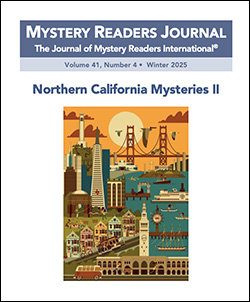Thursday, January 8, 2026
Call for Articles Mystery Readers Journal (42:1): Faires, Fetes, & Festivals
Wednesday, January 7, 2026
Tuesday, January 6, 2026
St Hilda's Crime Fiction Weekend: September 4-6, 2026
Monday, January 5, 2026
2026 Left Coast Crime “Lefty” Award Nominations
Left Coast Crime 2026 will be presenting four Lefty Awards at our 36th annual convention, to be held this February in San Francisco: Humorous, Historical, Debut, and Best. The awards will be voted on at the convention and presented at a banquet on Saturday, February 28, at the Hyatt Regency on the Embarcadero. The Lefty nominees have been selected by convention registrants.
2026 Lefty Award nominees for books published in 2025:
Lefty for Best Humorous Mystery Novel.
The nominees are:
• Ellen Byron, Solid Gold Murder (Kensington)
• Jennifer J. Chow, Star-Crossed Egg Tarts (St. Martin’s Paperbacks)
• Elizabeth Crowens, Bye Bye Blackbird (Level Best Books)
• Catriona McPherson, Scot’s Eggs (Severn House)
• Cindy Sample, All’s Faire in Love and Murder (Cindy Sample Books)
Lefty for Best Historical Mystery Novel for books set before 1970
(The Bill Gottfried Memorial).
The nominees are:
• Cara Black, Huguette (Soho Crime)
• Mariah Fredericks, The Girl in the Green Dress (Minotaur Books)
• Dianne Freeman, A Daughter’s Guide to Mothers and Murder (Kensington)
• Claire M. Johnson, City Lights (Level Best Books)
• Laurie R. King, Knave of Diamonds (Bantam)
• Rob Osler, The Case of the Missing Maid (Kensington)
Lefty for Best Debut Mystery Novel.
• Adrian Andover, Whiskey Business (Chestnut Avenue Press)
• Kristen L. Berry, We Don’t Talk About Carol (Bantam)
• Laurie L. Dove, Mask of the Deer Woman (Berkley)
• Sue Hincenbergs, The Retirement Plan (William Morrow)
• Marisa Kashino, Best Offer Wins (Celadon Books)
• Diane Schaffer, Mortal Zin (Sibylline Press)
Lefty for Best Mystery Novel (not in other categories).
The nominees are:
• Lou Berney, Crooks (William Morrow)
• Claire Booth, Throwing Shadows (Severn House)
• Tracy Clark, Edge (Thomas & Mercer)
• Leslie Karst, Waters of Destruction (Severn House)
• James L’Etoile, River of Lies (Oceanview Publishing)
• Gigi Pandian, The Library Game (Minotaur Books)
Left Coast Crime Conventions are annual events sponsored by mystery fans, both readers and authors. Held in the western half of North America, LCC’s intent is to host an event where readers, authors, critics, librarians, publishers, and other fans can gather in convivial surroundings to pursue their mutual interests. Lefty Awards have been given since 1996.
Returning to The City, where Left Coast Crime held its first two conventions, the 36th Annual Left Coast Crime Convention will take place in San Francisco, February 26 – March 1, 2026. This year’s Guests of Honor are authors Robin Burcell and Gary Phillips. Randal Brandt is the Fan Guest of Honor, and author Leslie Karst will serve as Toastmaster.
Left Coast Crime is a 501(c)(3) nonprofit corporation holding annual mystery conventions in the West. Each LCC convention raises money to support a local literary organization, and is staffed entirely by volunteers.
For more information on Left Coast Crime 2026, please visit www.leftcoastcrime.org/2026/
Sunday, January 4, 2026
Mystery Readers Journal: Northern California Mysteries II (41:4)
Volume 41, No. 4, Winter 2025

Buy this back issue! Available in hardcopy or as a downloadable PDF.
TABLE OF CONTENTS
ARTICLES
- They Didn’t Intend to Be Detectives… by Aubrey Nye Hamilton
- The Air Smelled Like Redwoods by Rona Bell
AUTHOR! AUTHOR!
- Northern California—in My Blood, in My Books by Juliet Blackwell
- A Time Traveler in the East Bay by Mary Adler
- Did a Charlie Chan Film Influence the Zodiac Murders? by Lou Armagno
- If You’ve Got the Lipstick… by David Corbett
- Climate Fiction in Northern California by Mary Flodin
- Just Say “Yes” to Stories from the Bay Area by Meredith Blevins
- Why I Set My Stories in Northern California by Daryl Wood Gerber
- San Francisco Wild by Toni Dwiggins
- Setting: Real or Invented? by Vinnie Hansen
- Mild-Mannered Men in Northern California by Walter Horsting
- I Have a Wild Imagination by Nancy Lynn Jarvis
- Following the Money to Silicon Valley by Ron Katz
- Baking Up Good Mystery in the Northern California Redwoods by Victoria Kazarian
- The Fault Lines in Northern California by Ellen Kirschman
- 1860s San Francisco— A Perfect Place for a Mystery by Nancy Herriman
- It Had to Be San Francisco… by Barry Lancet
- The City, My City by Lexa Mack
- World Building: It’s Not Just for Science Fiction and Fantasy by A.B. Michaels
- Feng Shui-by-the-Sea by Denise Osborne
- A Fog-Shrouded Lens by Tim Maleeny
- A Fish Out of Water in Oakland by Brad Parks
- The Babylon Deception, a Northern California Mystery by Ray Pace
- The Estuary Kept Its Secrets by Susan Paturzo
- Red Rock Island: Where Imagination Found a Home by Alec Peche
- The Cook, the Inspector, and the City by the Bay by Joanne Pence
- A Reader and a Writer Walk into a Bar by Karen A. Phillips
- Northern California: The Lost Highway by Alexandra Sokoloff
COLUMNS
- Mystery in Retrospect: Reviews
- Crime Seen: The Streets of San Francisco by Kate Derie
- Cop Ten: The Streets of… Everyplace Else but San Francisco by Jim Doherty
- From the Editor’s Desk by Janet A. Rudolph








